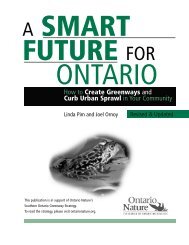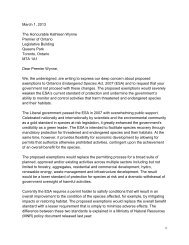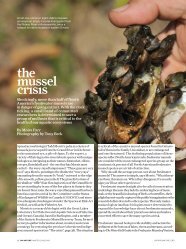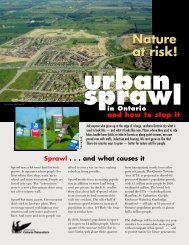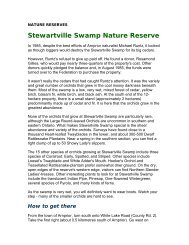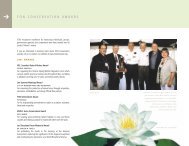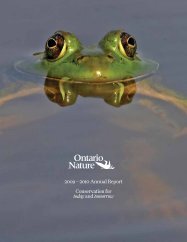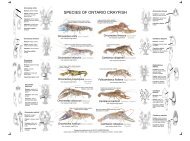The Green Way Forward - Ontario Nature
The Green Way Forward - Ontario Nature
The Green Way Forward - Ontario Nature
Create successful ePaper yourself
Turn your PDF publications into a flip-book with our unique Google optimized e-Paper software.
3. Assess, control and prevent the negative impacts of infrastructure<br />
development on natural heritage.<br />
Infrastructure development has too often been seen as inevitable for growth and has thus been<br />
exempted from policy measures intended to protect natural heritage values. For example,<br />
the privileging of infrastructure development over the protection of natural heritage features in<br />
the Oak Ridges Moraine Conservation Plan has undermined efforts to protect waterways,<br />
forests and wetlands in the region. If infrastructure continues to be approved with few or no<br />
constraints, then hope for a healthy, resilient natural heritage system in southern <strong>Ontario</strong> is<br />
severely compromised. <strong>The</strong> Province must seek and implement solutions that allow for<br />
development to occur without the careless destruction of natural systems.<br />
4. Assert tighter controls on aggregate extraction and develop an integrated<br />
plan for aggregate conservation and site rehabilitation.<br />
In many instances, aggregate development trumps provincial, regional and municipal protection<br />
of natural heritage features. For example, aggregate extraction is ongoing in the Niagara<br />
Escarpment and has not slowed even with the implementation of the <strong>Green</strong>belt Plan.<br />
Provincial policy does not require demonstration of the need for aggregate extraction before<br />
development proposals are approved, and, consequently, aggregate extraction is treated<br />
as inevitable and unstoppable. <strong>The</strong> Province must develop a comprehensive aggregate<br />
conservation and site rehabilitation strategy to promote the substitution, reduction, reuse and<br />
recycling of aggregate resources; the improved rehabilitation of sites; a detailed analysis of<br />
future supply and demand; and the identification of priority areas for resource extraction that<br />
do not conflict with other land use considerations.<br />
5. Integrate natural heritage protection into the operations and policies of all<br />
ministries involved in land use planning and environmental protection.<br />
To be effective, the protection of natural heritage in <strong>Ontario</strong> must be better coordinated among<br />
relevant ministries. For example, <strong>Ontario</strong>’s Biodiversity Strategy (MNR, 2005) should be integrated<br />
with the Provincial Policy Statement, the Growth Plan for the Greater Golden Horseshoe and<br />
<strong>Ontario</strong>’s Action Plan on Climate Change so that all plans include specific elements to protect<br />
biodiversity through land use planning and growth management initiatives. Effective land use<br />
planning, protection of biodiversity and adaptation to climate change require the collaboration<br />
and cooperation of all relevant ministries.<br />
7 <strong>The</strong> <strong>Green</strong> <strong>Way</strong> <strong>Forward</strong> A Review of Natural Heritage Policies for Southern <strong>Ontario</strong>



